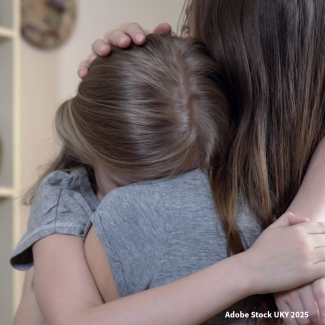Listen to a short summary of this research brief (1:33)

Volume 13, Issue 4, October 2025 Evidence in Action A quarterly research brief from the Center on Trauma and Children
Intergenerational continuity of childhood sexual and physical abuse: Using network analysis to explore risk
Gusler, S., Whitt, A., Sprang, G., & Eslinger, J. (2025). Intergenerational continuity of childhood sexual and physical abuse: Using network analysis to explore risk. Journal of Family Psychology. Advance online publication. https://dx.doi.org/10.1037/fam0001400
The Study
This study examined how experiences of childhood sexual and physical abuse persist across generations and identified interconnected risk factors that contribute to this continuity of abuse. Using secondary data from 410 mother–child dyads with substantiated cases of child maltreatment, the researchers applied network analysis to explore complex relations among maternal trauma histories, mental health, substance use, and parenting behaviors.
Results showed that in 8.5% of families both the mother and child had experienced childhood sexual abuse, and in 7.8% of families both the mother and child had experienced childhood physical abuse. Both mother and child experiencing sexual abuse was associated with mothers having a substance use disorder and having greater difficulty managing anger and emotions. Network analysis further showed how risk factors are interconnected. Specifically, mothers who experienced physical and/or sexual abuse as children were more likely to struggle with low self-esteem, depression, and feelings of isolation as adults. These challenges were connected to facing many ongoing stressors or crises in adulthood, which in turn were related to poorer recovery from trauma and a greater risk for anger outbursts and substance use. For childhood physical abuse, one key pattern stood out: mothers who were physically abused as children were more likely to use harsher discipline with their own children and using harsher discipline was associated with seeing their child as difficult.

Translational Tips
- The findings show how the impact of mothers’ past and ongoing trauma and adversity can compound over time and increase the risk of their children experiencing abuse.
- For professionals working with families in the child welfare system, it’s important to screen not only for mental health concerns and substance use but also for past and ongoing adversity. This helps ensure that mothers get the right kinds of support and resources they need.
- For families involved in child welfare, intervention and prevention efforts that target only parenting behaviors may be insufficient.
- Instead, trauma-informed approaches addressing maternal mental health, substance use, prior trauma history, and current interpersonal safety are crucial to breaking intergenerational cycles of abuse.
- This approach demands collaboration across systems (child welfare, behavioral health, and community services). Child welfare, mental health, and community service providers should work together through coordinated case planning that considers how these risks are connected. This kind of teamwork can make prevention and intervention efforts far more effective in helping families heal and build safer, healthier futures.
Subscribe to the Evidence in Action Research Brief
Sign up here if you want to receive Evidence in Action in your inbox!